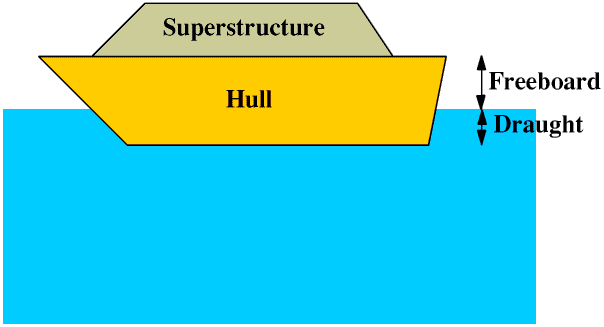Buoyancy

Ships
If we slowly lower an object into water, as the volume of water it displaces increases so will its buoyancy. If the buoyancy becomes equal to the weight of the object before it is fully submerged it will float. To read an explanation of buoyancy please click here 
A ship (or anything else that floats) sinks into the water until it has displaced its own weight of water, then it will not sink any further.
Submarines are designed to be capable of operating on the surface of the sea or under it - to read about them please click here 
Some materials, such as most woods, are less dense than water and will float whatever their shape, but you can only make an object made out of a material denser than water float if you make it the right shape to displace a lot of water.
Try making a boat out of plasticene (or other modelling clay). A corracle (round) shape is best unless you are very good at clay modelling. Once you have made it float you can experiment with it: see for example how as you put small weights into it it sinks lower into the water so that it displaces more water and so the buoyance increases until it is equal to the new weight. If of course you put too much weight into it it will get so low in the water that water gets into it and it will sink.
The main body of a ship is called the hull, and the deck at the top of the hull is called the main deck. Anything above the main deck is called the superstructure. The distance from the bottom of the hull to the waterline is called the draught and the distance from the waterline to the main deck is called the freeboard. As you load a ship with cargo or passengers and fuel it gets heavier and so must displace more water to increase the buoyancy to equal the new weight, and so the draught increases and the freeboard decreases.

If the freeboard is too small the water may break over the top of the hull and the ship may be swamped and sink. During the 19th century many merchant ships were deliberately overloaded so that they would sink and the owners could claim the insurance money. An English MP called Samuel Plimsoll (1824 - 1898) campaigned for many years to make ships safer, and as a result in 1876 Parliament passed a law ordering British ships to have a special line drawn through a circle, the Plimsoll Line, painted on the side. This had to be visible above the water at all times. However, cold water is denser than warm water, and salty water is denser than fresh water, so a ship will float higher in cold or salty water than warm or fresh water. Today therefore ships have to be marked not only with the Plimsoll Line but also with International Load Lines which take this into account.

To link to a site about Samuel Plimsoll please click here 
Stability
Most ships are longer than they are wide and approximately symmetrical about the centre line.

Getting a ship to float is one thing, getting it to float without tipping over in the water or rolling so much that everyone on board is sea-sick is something else altogether. This is discussed in another page of my Web Site - to read it please click here 
© Barry Gray February 2004

![]()



![]()